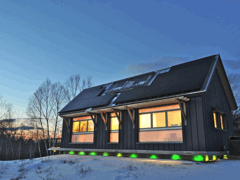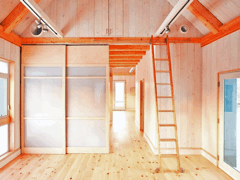Building Green with Less Green
Air Date: Week of August 13, 2010
 |
Host Jeff Young visits a super energy-efficient, solar powered house in Maine. Its owner uses technology he calls “state of the shelf,” rather than state of the art. The goal is a green house that’s as economically affordable as it is environmentally sustainable.
Transcript
YOUNG: Green housing is all the rage, but the price tags on a lot of those energy-saving homes, could put a household in the red. Well, one pioneering homeowner says green living can be more affordable and accessible. Keith Collins, a retired physician in Maine, brought together top designers and architects to help him build what he calls the Bright Built Barn. When I called to arrange a visit, Dr. Collins told me to look for the tight little house on a hill, with a south-facing roof. So I hit the road to mid-coast Maine.

Over its first year, the house has generated five thousand more kilowatt hours from solar panels than it used.
[MUSIC]
[KNOCKING DOOR; DOOR OPENING]
YOUNG: Hello, there!
COLLINS: Hi, Jeff - Welcome to Maine.
YOUNG: Thanks for having me.
COLLINS: Well, thanks for coming up and I’d love to show you Bright Built Barn, and it’s a beautiful sunny day, and we’re making lots of electricity.
YOUNG: Dr. Collins has solar power in his place and many of the things you’d expect from energy-efficient design. Double thick insulated walls, triple paned windows and obsessive weatherproofing. But it also has something you might not expect – charm. Lots of natural light, pretty pine floors and exposed spruce beams reaching up to a high vaulted ceiling.
COLLINS: You know, some people think that to go green we should wear burlap bags and eat rocks, and I’m just not into suffering, you know? I think that if we put our minds to it we ought to be able to live very well, as well as protect the planet.
YOUNG: Let’s take a walk in here and talk a bit about your lighting, because I know that’s another area where we tend to use a lot of energy.
.gif)
Energy ratio for the green house. Energy production is green and energy consumption is in red, while the blue shows the energy flow to the grid.
COLLINS: If you look over here you see these lights are what are called LED lights – they’re light emitting diodes. They’re basically little computer chips that give off light. Each of these fixtures is using five watts and giving off the same amount of light as a 75-watt incandescent bulb, so there’s a 15 times more energy efficient.
[KNOCKING SOUNDS]
YOUNG: We climb above the moveable birch panel walls to the loft, for a look at the solar system: 30 voltaic panels provide electricity and solar thermal tubes heat water, which also heats the house. Dr. Collins likes the medical metaphor. He calls this the heart of the house. And in the corner, is the brain: a metal box with a digital display.
COLLINS: This is what I call my report card. Here it says – and this is from the day we turned on all the systems – how many kilowatt-hours have we consumed here in the barn, and it’s 1,247-kilowatt hours.
YOUNG: That’s for like a year, more than a year?
COLLINS: Yeah, that’s a year. However, we produce 6,342-kilowatt hours in that year. Giving us a net positive of 5,094-kilowatt hours as of today October 17, 2009.
YOUNG: So, your meter, your meter spins backwards?
COLLINS: Absolutely. And it spins backwards a lot. You know, basically any really sunny day, my meter’s spinning backwards.
YOUNG: And the grid, it’s your battery?
COLLINS: The grid is my battery. In other words, what we do is we put the energy out on the grid when we’re making excess, and when we’re not making excess, and we’re consuming more than we make, we draw from the grid.
YOUNG: There’s some information technology at work here to make everything play well together. But, by and large, this is low-tech, this isn’t high-tech?
COLLINS: And that’s what we tried to do. We were aiming for the state of the shelf, not the state of the art. A real goal in building this was not to build something that would be Buck Rogers, high-tech, something you needed a degree in astrophysics to run – this was something where anybody could have a house like this.

The green lights on the bottom of the house show when it’s producing more energy than it needs (glowing green) or using energy from the grid (glowing red).
[WALKING DOWN STEPS]
YOUNG: Putting clean electrons back into the grid is also part of Dr. Collins’ plan to make the house truly carbon-neutral. He kept tabs on the CO2 emissions from construction, even using local wood, and keeping the house small – just 30 by 24 feet – he still put 500 metric tons of CO2 into the atmosphere. Collins calls that his house’s carbon debt and he can only pay it off if the house lasts.
COLLINS: Everything in the barn is designed to last 200 years, except me. [Laugh] I’m not going to last 200 years, which means I’ve got to build something not just for me, I’ve got to build it for all those generations after me who will come to use it and have to feel that it is functional, but they also have to feel that it’s beautiful.
YOUNG: So, aesthetics matter. If it’s going to be green, it’s going to be good looking, too?
COLLINS: Absolutely, because, in fact ugly houses get smashed down. So, what we need to do is we need to make a space, which is beautiful so that people will take the energy to adapt it to their needs. We are then offsetting the carbon that we put off into the atmosphere to build it.
YOUNG: You’re paying back your carbon debt, little by little.
COLLINS: Absolutely, little by little, and just to give you some numbers: 5,000. Well, if you do the math, those 5,000-kilowatt hours equate to about five metric tons of carbon dioxide.
YOUNG: Five tons down, and 495 to go.
COLLINS: 495 to go, right? So, we’ve only got 99 more years to go, and we’ll have paid off our debt. We’re already planning the party.
YOUNG: Well, Dr. Keith Collins, thanks very much. It’s a great pleasure.
COLLINS: It was great to see you, thanks for coming by.
YOUNG: Now, about the money…Dr. Collins says a house like this one, with the solar system, would be about $220,000. That sounds like a lot, but averaged over the life of a 30-year mortgage, it’s about the same cost as normal, inefficient construction. And Dr. Collins will probably never have to pay another power or heat bill. You can see pictures and plans for his Bright Built Barn at our website: LOE dot org.
Links
Living on Earth wants to hear from you!
Living on Earth
62 Calef Highway, Suite 212
Lee, NH 03861
Telephone: 617-287-4121
E-mail: comments@loe.org
Newsletter [Click here]
Donate to Living on Earth!
Living on Earth is an independent media program and relies entirely on contributions from listeners and institutions supporting public service. Please donate now to preserve an independent environmental voice.
NewsletterLiving on Earth offers a weekly delivery of the show's rundown to your mailbox. Sign up for our newsletter today!
 Sailors For The Sea: Be the change you want to sea.
Sailors For The Sea: Be the change you want to sea.
 The Grantham Foundation for the Protection of the Environment: Committed to protecting and improving the health of the global environment.
The Grantham Foundation for the Protection of the Environment: Committed to protecting and improving the health of the global environment.
 Contribute to Living on Earth and receive, as our gift to you, an archival print of one of Mark Seth Lender's extraordinary wildlife photographs. Follow the link to see Mark's current collection of photographs.
Contribute to Living on Earth and receive, as our gift to you, an archival print of one of Mark Seth Lender's extraordinary wildlife photographs. Follow the link to see Mark's current collection of photographs.
 Buy a signed copy of Mark Seth Lender's book Smeagull the Seagull & support Living on Earth
Buy a signed copy of Mark Seth Lender's book Smeagull the Seagull & support Living on Earth

